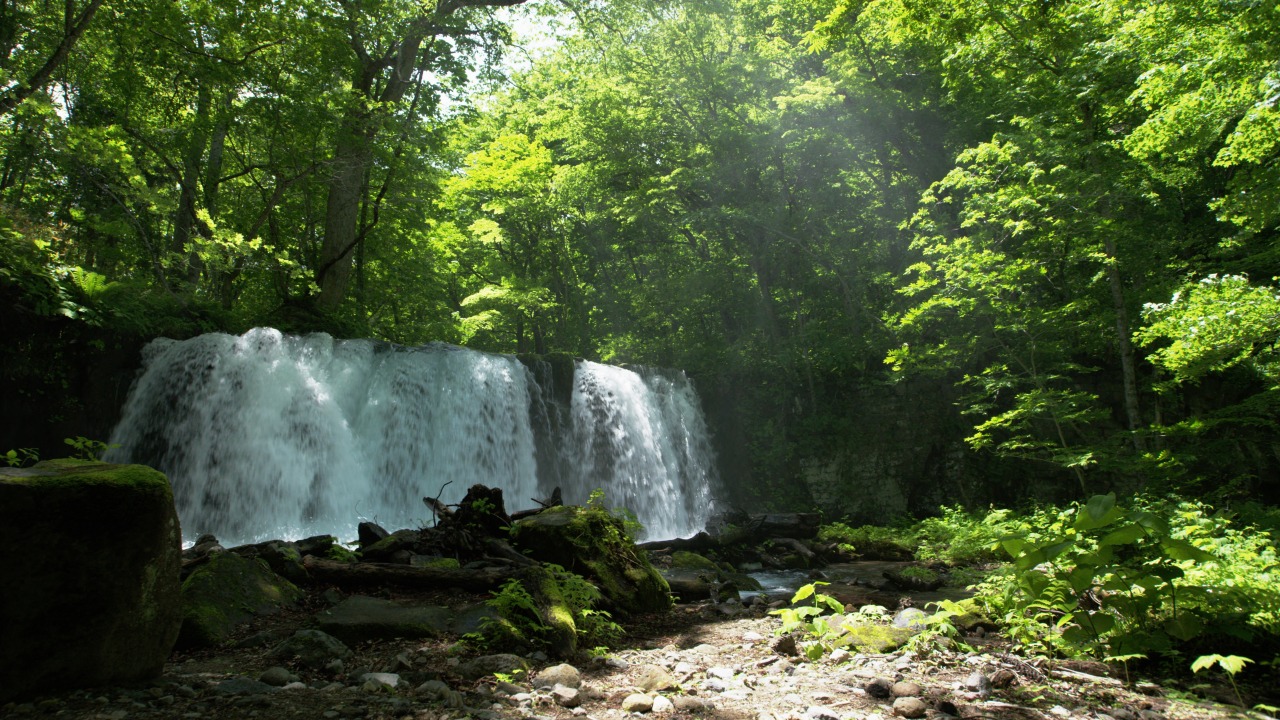It’s no secret that Japan has a stunning amount of beauty. From the lavender fields of Furano in Hokkaido down to the crystal clear beaches of Okinawa, this small country is filled with gorgeous nature, contemporary museums, mountainside temples and of course, those pretty springtime cherry blossoms and colourful autumn leaves.
With so much to see, it's impossible to do Japan justice with just one visit. This explains why people miss Japan more than any other country in the world. So this extraordinary island archipelago definitely calls for repeats visits – how else are you going to see all these 24 beautiful sight in Japan?
Kiyotsu Gorge and the Tunnel of Light, Niigata prefecture

Niigata prefecture’s Kiyotsu Gorge is a massive natural marvel with volcanic columns, called columnar jointing, overlooking a dramatic river view. After the walking trails were deemed unsafe and closed to the public in 1988, Ma Yansong and the MAD Architects team built the Tunnel of Light, a 750m-long tunnel leading out to the gorge, so visitors can safely view its panoramic beauty.
Kamikochi, Nagano
A lush green plateau on the Nagano prefecture side of the Northern Japanese Alps, Kamikochi offers some of Japan’s most spectacular mountain scenery with minimal hiking effort. Most visitors just hover around Kappabashi (Kappa Bridge) and for good reason. For one, the bus stop is just nearby. But more importantly, here you get to take in the grand view: a wooded riverbank surrounded by a fortress of mountains, which in autumn blushes in shades of yellow, orange and red.
Beat the crowd by starting at the quiet Taisho Pond, whose pristine surface in the early morning mirrors its gorgeous surroundings. From here, it’s an easy hour-long hike through marshlands to Kappabashi, where you can break for a meal at one of several cafés and restaurants. For day trippers, you can then go further into the forest; another 90 minutes’ walk will take you to the atmospheric Myojin Pond.
Oirase Gorge, Aomori

This picturesque gorge in the mountains of Aomori is one of Japan’s top autumn destinations. The 9km-long trail from Ishigeo to Nenokuchi at the mouth of Lake Towada is breathtaking – not that it’s a strenuous hike but because of the gorgeous scenery all along the way. The gushing Oirase Stream snakes through a blazing red and orange forest studded with moss-covered boulders, with multiple waterfalls feeding into the running water. It’s Japanese autumn at its best.
Set aside three hours for a one-way trek, and you can hop on a sightseeing ferry at the end of the trail at Nenokuchi for more autumn foliage along Lake Towada. Though you’d need some good stamina, don’t worry if you can’t do the entire nine kilometres. There are bus stops on the road running alongside the stream, where you can catch a ride to any point on the trail.
Kinkakuji Temple, Kyoto

Otherwise known as the Golden Temple, Kinkakuji is a Zen Buddhist temple covered in gold, a miraculous and shiny site in the middle of traditional Kyoto. In fact, the temple is so beautiful that a young monk attempted to burn it down in 1950, inspiring Yukio Mishima’s famous novel ‘The Temple of the Golden Pavilion’. First, you walk along a path to see the temple and its reflection before you eventually see it close up, so be prepared for multiple photo ops. Head there in the early morning or late afternoon for smaller crowds and less glinting from the gold leaf.
Mt Fuji, Yamanashi

Japan’s crown jewel and arguably the most beautiful place in the country, Mt Fuji is a must for any visitor. There are plenty of places to see the grand mountain, but the views from Arakurayama Sengen Park, which boasts the majestic Chureito Pagoda, and from Lake Kawaguchi best capture its beauty.
Lake Kawaguchi, one of the Fuji Five Lakes, has glorious views of Mt Fuji, especially in winter when the sky is mostly clear and you can see the volcano’s reflection in the water. Having said that, the near-perfect symmetry of Mt Fuji is a spectacular sight year-round, regardless of where you see it from.
Shirakawa-go, Gifu prefecture

Deep in Gifu prefecture lies Shirakawa-go, a perfectly preserved Japanese village and Unesco World Heritage Site, filled with traditional gassho-zukuri style farmhouses known for their thatched, triangular roofs that resemble praying hands. Now, most of the farmhouses have been converted into museums, restaurants and even hotels, but visitors can still explore the inside of the houses to admire the idiosyncratic architecture, held together by wooden beams. The houses are especially picturesque in winter – all covered in snow, they look like gingerbread houses.
Motonosumi Shrine, Yamaguchi

Tunnels of vermilion torii gates are a common sight in Japan. There’s Fushimi Inari in Kyoto and Nezu Shrine in Tokyo, but Motonosumi Shrine in the seaside town of Nagato is the most picturesque. A relatively new shrine, built in 1955, it consists of 123 torii gates that lead down dramatic cliffs, with spectacular ocean views to boot. Unlike most shrines where you just toss a coin into an offering box, here you’ll have to shoot your donation into a box at the top of the final torii gate, which stands six metres tall. If you make it, your wish might just come true.
Narai, Nagano
Along the historic Nakasendo, the mountainous route which connected old Edo (present-day Tokyo) with Kyoto, is Narai, a post town in the picturesque Kiso Valley. This is one of the best places to catch a glimpse of Edo-period (1603-1868) life, as most of this then-prosperous town is so well-preserved that its wooden buildings stretch for a 1km block. Many of the heritage houses have been adapted into restaurants, minshuku (Japanese bed and breakfast) and stores while two former residences – Nakamura Residence and Kamidonya Shiryokan – are preserved as they were back in the day. Narai is incredibly photogenic in autumn, when bright foliage lights up the surrounding Kiso mountain range.
